I am trying to optimize the click rate of some article or advertisement (action) given a device type (context) with VowpalWabbit (following this article vw tutorial). However, I am not able to make it converge to the optimal actions reliably.
I created a minimal working example (sorry for the length):
import random
import numpy as np
from matplotlib import pyplot as plt
from vowpalwabbit import pyvw
plt.ion()
action_space = ["article-1", "article-2", "article-3"]
def running_mean(x, N):
cumsum = np.cumsum(np.insert(x, 0, 0))
return (cumsum[N:] - cumsum[:-N]) / float(N)
def to_vw_example_format(context, cb_label=None):
if cb_label is not None:
chosen_action, cost, prob = cb_label
example_string = ""
example_string += "shared |User device={} \n".format(context)
for action in action_space:
if cb_label is not None and action == chosen_action:
example_string += "1:{}:{} ".format(cost, prob)
example_string += "|Action ad={} \n".format(action)
# Strip the last newline
return example_string[:-1]
# definition of problem to solve, playing out the article with highest ctr given a context
context_to_action_ctr = {
"device-1": {"article-1": 0.05, "article-2": 0.06, "article-3": 0.04},
"device-2": {"article-1": 0.08, "article-2": 0.07, "article-3": 0.05},
"device-3": {"article-1": 0.01, "article-2": 0.04, "article-3": 0.09},
"device-4": {"article-1": 0.04, "article-2": 0.04, "article-3": 0.045},
"device-5": {"article-1": 0.09, "article-2": 0.01, "article-3": 0.07},
"device-6": {"article-1": 0.03, "article-2": 0.09, "article-3": 0.04}
}
#vw = f"--cb_explore 3 -q UA -q UU --epsilon 0.1"
vw = f"--cb_explore_adf -q UA -q UU --bag 5 "
#vw = f"--cb_explore_adf -q UA --epsilon 0.2"
actor = pyvw.vw(vw)
random_rewards = []
actor_rewards = []
optimal_rewards = []
for step in range(200000):
# pick a random context
device = random.choice(list(context_to_action_ctr.keys()))
# let vw generate probability distribution
# action_probabilities = np.array(actor.predict(f"|x device:{device}"))
action_probabilities = np.array(actor.predict(to_vw_example_format(device)))
# sample action
probabilities = action_probabilities / action_probabilities.sum()
action_idx = np.random.choice(len(probabilities), 1, p=probabilities)[0]
probability = action_probabilities[action_idx]
# get reward/regret
action_to_reward_regret = {
action: (1, 0) if random.random() < context_to_action_ctr[device][action] else (0, 1) for action in action_space
}
actor_action = action_space[action_idx]
random_action = random.choice(action_space)
optimal_action = {
"device-1": "article-2",
"device-2": "article-1",
"device-3": "article-3",
"device-4": "article-3",
"device-5": "article-1",
"device-6": "article-2",
}[device]
# update statistics
actor_rewards.append(action_to_reward_regret[actor_action][0])
random_rewards.append(action_to_reward_regret[random_action][0])
optimal_rewards.append(action_to_reward_regret[optimal_action][0])
# learn online
reward, regret = action_to_reward_regret[actor_action]
cost = -1 if reward == 1 else 0
# actor.learn(f"{action_idx+1}:{cost}:{probability} |x device:{device}")
actor.learn(to_vw_example_format(device, (actor_action, cost, probability)))
if step % 100 == 0 and step > 1000:
plt.clf()
axes = plt.gca()
plt.title("Reward over time")
plt.plot(running_mean(actor_rewards, 10000), label=str(vw))
plt.plot(running_mean(random_rewards, 10000), label="Random actions")
plt.plot(running_mean(optimal_rewards, 10000), label="Optimal actions")
plt.legend()
plt.pause(0.0001)
Essentially, there are three possible actions (article 1-3) and 6 contexts (device 1-6), each combination having a certain CTR (Click Through Rate) and an optimal action given a context (article with highest ctr given the device). With each iteration, a random context is sampled and the reward/regret for each action is computed. The cost used by VowpalWabbit to learn is -1 if the reward is 1 (a user clicked) or 0 if the reward is 0 (user did not click). With time, the algorithm is supposed to find the best articles for each device.
Some results (Average Reward over time):


The problems:
- Starting the same program multiple times, leads to differing results (sometimes not converging at all, sometimes finding the optimal and staying with it)
- With a bad start (early convergence to sub-optimal arms), with more time, the algorithm is still not moving to better arms.
- It seems that the algorithm is early trapped in a local minimum, which defines the performance for the rest of the experiment. (even with some exploration factor)
As the CTRs are fairly small and a lot of playouts are needed for convergence, I understand the difficulty of the problem. I would however expect that with time, the algorithm would find the optimum.
Did I miss something in the configuration of VowpalWabbit?

